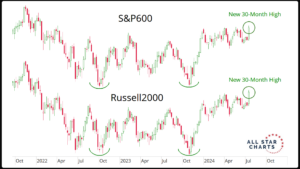Happy Summer! We hope this commentary finds you and your loved ones well as we enter the second half of 2024. Like this summer’s heat wave, the overall equity markets have been scorching hot as well. The Nasdaq Composite has been leading the way this year; the tech heavy index was up 8.5% in the second quarter and finished the first half of 2024 up 18.6%. The S&P 500 increased 4.3% in the second quarter and 15.3% for the first half. Meanwhile, the Dow Jones Industrial Average has lagged, with the second quarter trending down -1.3% and posting only a 4.8% return in the first half.

Much like in 2023, artificial intelligence remained a pivotal force behind these significant gains. Most of the S&P 500’s progress was concentrated in the “Magnificent Seven” big tech companies, leaving other stocks trailing. Nvidia (NVDA) stood out as the leader, with its stock price soaring by 149% this year. In June, Nvidia’s valuation surpassed $3 trillion for the first time, momentarily making it the world’s largest public company.
Nvidia’s remarkable performance helped the S&P 500 achieve 31 record-high closes so far this year. This was despite inflation data that dampened investors’ expectations regarding the timing and frequency of Federal Reserve interest rate cuts. There are several reasons to believe the momentum could continue in the second half. AI development is still in its early stages, with the current $200 billion market projected to exceed $1 trillion by the end of the decade. This growth potential suggests that companies will continue to invest in AI projects, driving revenue growth for tech companies involved in providing AI chips and services.
At the beginning of the year, Wall Street anticipated that the Federal Reserve might ease rates up to six times in 2024. However, persistent inflation data led investors to temper those expectations. So far, the Federal Reserve has not reduced rates from their 23-year high.
Recent data has offered some hope. June CPI figures came in well below expectations for the second consecutive month, bolstering confidence that inflation is moving towards the Fed’s 2% target. As we write, Federal Reserve Chair Jay Powell indicated that the central bank is approaching a point where it might start cutting interest rates.
Although unlikely, recession risk is also not entirely off the table. Economic growth decelerated in the first half of the year, with the US GDP growth rate dropping to 1.4% in the first quarter from 3.4% in the fourth quarter of 2023. This slowdown is attributed to the ongoing effects of the Federal Reserve’s rate-hiking cycle. Consumer spending has also somewhat diminished, and the residual economic boost from the pandemic is waning.
However, this slowdown seems to indicate more of a soft landing rather than a recession. Various economic indicators—rising credit card delinquencies, slowing manufacturing activity and retail sales, and a weakening labor market—point to a normalization from the unsustainably high levels experienced during the pandemic, rather than a problematic decline. The consumer remains the key going forward, and although spending has pulled back, the US consumer appears to be far from tapped out.
Investors are showing increasing confidence that the Federal Reserve will lower interest rates by the end of its September meeting. This optimism is reflected in market expectations, which recently indicated a 100% chance of a rate cut in September, according to the CME FedWatch Tool. This marks a significant increase from the 70% likelihood predicted just a month before.
As we look ahead, it’s helpful to examine historical trends. Historically, a strong first half often leads to a successful second half. Since 1950, the S&P 500 has gained 10% or more in the first half on 22 occasions. In 18 of those instances, the market continued to advance in the second half, with the average annual gain exceeding 25%. This year’s performance ranks as the fifth-best first half in the past 25 years, indicating a potential continuation of gains if historical patterns hold true.
Despite these optimistic signs, risks do remain. Fewer companies are participating in these new all-time highs in the market. The rally in tech stocks may be overblown due to high valuations driven by a few major companies. An equal-weight version of the S&P 500, which treats all companies equally regardless of size, has lagged behind the market value-weighted version by 10 percentage points since January, marking the widest underperformance ever for the first six months of the year.
Broader market participation is needed for this bull market to have longer legs. Non-tech companies could drive the next phase of the rally. Historically, in four prior bull runs since 1990, the equal-weight index outperformed the main benchmark by 15 percentage points on average by the 20th month. Currently, the equal-weight gauge has underperformed the S&P 500 by 16 percentage points over the same period.
is needed for this bull market to have longer legs. Non-tech companies could drive the next phase of the rally. Historically, in four prior bull runs since 1990, the equal-weight index outperformed the main benchmark by 15 percentage points on average by the 20th month. Currently, the equal-weight gauge has underperformed the S&P 500 by 16 percentage points over the same period.
As we start the third quarter, signs of broader-based market participation seem to be appearing. Regardless of the exact timing, investors are increasingly confident that interest rates will decrease soon. This anticipation has influenced market behavior, contributing to a broader stock market rally. Investors have shifted focus from the previously dominant tech sector to other areas such as Real Estate, and Industrials, both of which are sensitive to interest rate changes.
 Small cap stocks have also surged recently, with indexes posting 30-month highs after lagging the large cap indexes for the last couple years. Small cap stocks are especially sensitive to interest rates, and their recent resurgence reflects the market’s confidence in the potential for Fed easing in the near future. This recent outperformance is a signal to many that inflation was last year’s problem and new data points now come into focus.
Small cap stocks have also surged recently, with indexes posting 30-month highs after lagging the large cap indexes for the last couple years. Small cap stocks are especially sensitive to interest rates, and their recent resurgence reflects the market’s confidence in the potential for Fed easing in the near future. This recent outperformance is a signal to many that inflation was last year’s problem and new data points now come into focus.
As always, we are monitoring current market conditions and making adjustments to portfolios as necessary. Though we do not have a crystal ball, we hope to anticipate changing market dynamics in order to participate in any further gains. Diversifying out of positions that have worked so well for us over the last couple years may be necessary as we move into the second half of 2024.
We believe that the strategies we manage are comprised of companies that are well-positioned for long-term success, are well run by capable management teams, and that their ownership over time will lead to positive outcomes.
We will remain patient and stick to the long-term plan, as we have worked with you to establish a unique, personal allocation target based on your financial position, risk tolerance, and investment timeline. We thank you for your ongoing confidence and trust. Please rest assured that our entire team will remain dedicated to helping you accomplish your financial goals, and please do not hesitate to contact us with any questions, comments, or to schedule a portfolio or financial plan review.

Scott A. Goginsky
Partner, Research Analyst and Portfolio Manager
Sources: Index and position returns – Nasdaq, CNN; Market statistics and outlook – CNN, The Motley Fool, Morningstar, Bloomberg; Interest rates and inflation – Yahoo Finance, Morningstar; Small cap index data – All Star Charts
Image Source: Magnificent Seven – gguy – stock.adobe.com
The information set forth regarding investments was obtained from sources that we believe reliable but we do not guarantee its accuracy or completeness. Neither the information nor opinion expressed constitutes a solicitation by us of the purchase or sale of any securities. Past performance does not guarantee future results.



Second Quarter 2024 Market Commentary
Scott A. Goginsky, CFA®
Happy Summer! We hope this commentary finds you and your loved ones well as we enter the second half of 2024. Like this summer’s heat wave, the overall equity markets have been scorching hot as well. The Nasdaq Composite has been leading the way this year; the tech heavy index was up 8.5% in the second quarter and finished the first half of 2024 up 18.6%. The S&P 500 increased 4.3% in the second quarter and 15.3% for the first half. Meanwhile, the Dow Jones Industrial Average has lagged, with the second quarter trending down -1.3% and posting only a 4.8% return in the first half.
Much like in 2023, artificial intelligence remained a pivotal force behind these significant gains. Most of the S&P 500’s progress was concentrated in the “Magnificent Seven” big tech companies, leaving other stocks trailing. Nvidia (NVDA) stood out as the leader, with its stock price soaring by 149% this year. In June, Nvidia’s valuation surpassed $3 trillion for the first time, momentarily making it the world’s largest public company.
Nvidia’s remarkable performance helped the S&P 500 achieve 31 record-high closes so far this year. This was despite inflation data that dampened investors’ expectations regarding the timing and frequency of Federal Reserve interest rate cuts. There are several reasons to believe the momentum could continue in the second half. AI development is still in its early stages, with the current $200 billion market projected to exceed $1 trillion by the end of the decade. This growth potential suggests that companies will continue to invest in AI projects, driving revenue growth for tech companies involved in providing AI chips and services.
At the beginning of the year, Wall Street anticipated that the Federal Reserve might ease rates up to six times in 2024. However, persistent inflation data led investors to temper those expectations. So far, the Federal Reserve has not reduced rates from their 23-year high.
Recent data has offered some hope. June CPI figures came in well below expectations for the second consecutive month, bolstering confidence that inflation is moving towards the Fed’s 2% target. As we write, Federal Reserve Chair Jay Powell indicated that the central bank is approaching a point where it might start cutting interest rates.
Although unlikely, recession risk is also not entirely off the table. Economic growth decelerated in the first half of the year, with the US GDP growth rate dropping to 1.4% in the first quarter from 3.4% in the fourth quarter of 2023. This slowdown is attributed to the ongoing effects of the Federal Reserve’s rate-hiking cycle. Consumer spending has also somewhat diminished, and the residual economic boost from the pandemic is waning.
However, this slowdown seems to indicate more of a soft landing rather than a recession. Various economic indicators—rising credit card delinquencies, slowing manufacturing activity and retail sales, and a weakening labor market—point to a normalization from the unsustainably high levels experienced during the pandemic, rather than a problematic decline. The consumer remains the key going forward, and although spending has pulled back, the US consumer appears to be far from tapped out.
Investors are showing increasing confidence that the Federal Reserve will lower interest rates by the end of its September meeting. This optimism is reflected in market expectations, which recently indicated a 100% chance of a rate cut in September, according to the CME FedWatch Tool. This marks a significant increase from the 70% likelihood predicted just a month before.
As we look ahead, it’s helpful to examine historical trends. Historically, a strong first half often leads to a successful second half. Since 1950, the S&P 500 has gained 10% or more in the first half on 22 occasions. In 18 of those instances, the market continued to advance in the second half, with the average annual gain exceeding 25%. This year’s performance ranks as the fifth-best first half in the past 25 years, indicating a potential continuation of gains if historical patterns hold true.
Despite these optimistic signs, risks do remain. Fewer companies are participating in these new all-time highs in the market. The rally in tech stocks may be overblown due to high valuations driven by a few major companies. An equal-weight version of the S&P 500, which treats all companies equally regardless of size, has lagged behind the market value-weighted version by 10 percentage points since January, marking the widest underperformance ever for the first six months of the year.
Broader market participation is needed for this bull market to have longer legs. Non-tech companies could drive the next phase of the rally. Historically, in four prior bull runs since 1990, the equal-weight index outperformed the main benchmark by 15 percentage points on average by the 20th month. Currently, the equal-weight gauge has underperformed the S&P 500 by 16 percentage points over the same period.
is needed for this bull market to have longer legs. Non-tech companies could drive the next phase of the rally. Historically, in four prior bull runs since 1990, the equal-weight index outperformed the main benchmark by 15 percentage points on average by the 20th month. Currently, the equal-weight gauge has underperformed the S&P 500 by 16 percentage points over the same period.
As we start the third quarter, signs of broader-based market participation seem to be appearing. Regardless of the exact timing, investors are increasingly confident that interest rates will decrease soon. This anticipation has influenced market behavior, contributing to a broader stock market rally. Investors have shifted focus from the previously dominant tech sector to other areas such as Real Estate, and Industrials, both of which are sensitive to interest rate changes.
As always, we are monitoring current market conditions and making adjustments to portfolios as necessary. Though we do not have a crystal ball, we hope to anticipate changing market dynamics in order to participate in any further gains. Diversifying out of positions that have worked so well for us over the last couple years may be necessary as we move into the second half of 2024.
We believe that the strategies we manage are comprised of companies that are well-positioned for long-term success, are well run by capable management teams, and that their ownership over time will lead to positive outcomes.
We will remain patient and stick to the long-term plan, as we have worked with you to establish a unique, personal allocation target based on your financial position, risk tolerance, and investment timeline. We thank you for your ongoing confidence and trust. Please rest assured that our entire team will remain dedicated to helping you accomplish your financial goals, and please do not hesitate to contact us with any questions, comments, or to schedule a portfolio or financial plan review.
Scott A. Goginsky
Partner, Research Analyst and Portfolio Manager
Sources: Index and position returns – Nasdaq, CNN; Market statistics and outlook – CNN, The Motley Fool, Morningstar, Bloomberg; Interest rates and inflation – Yahoo Finance, Morningstar; Small cap index data – All Star Charts
Image Source: Magnificent Seven – gguy – stock.adobe.com
The information set forth regarding investments was obtained from sources that we believe reliable but we do not guarantee its accuracy or completeness. Neither the information nor opinion expressed constitutes a solicitation by us of the purchase or sale of any securities. Past performance does not guarantee future results.